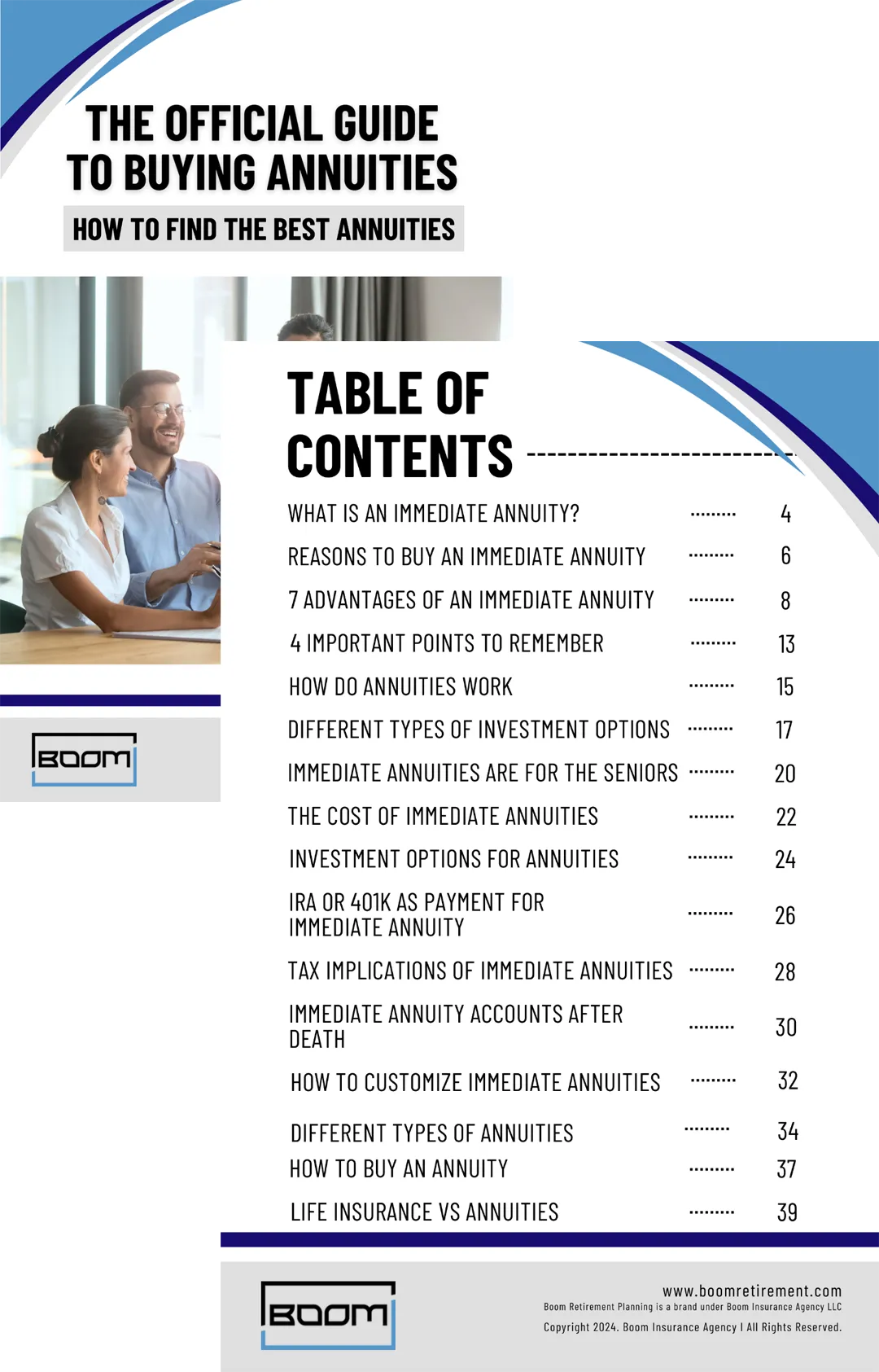
BOOM RETIREMENT SOLUTIONS
Strategies for Boosting Retirement Income

Top Retirement Cash Flow Risks
Why you need this Retirement Toolkit
Will outlive your retirement savings?
Will taxes and inflation erode your Retirement Nest Egg?
Will you head into retirement using an Accumulation Strategy or a Decumulation Strategy?
Will you maintain your lifestyle in a market downturn?
Are you prepared for RMD's and IRMAA?
BOOM RETIREMENT PLANNING
Strategies for Boosting Retirement Income
If You Ask 50 Financial Advisors,
"What is the best way to retire?".
You will get 50 different answers!
That is because despite all their training and certifications,
financial advisors each bring their own perspectives, experiences, and
biases to the table, leading to varied approaches and strategies tailored to their
unique understanding of the market, client needs, and risk tolerance.
Economic Science and Math proves...
There is Only One Optimal Way to Retire
Over 6 Decades of Research Created the 7 Steps Below.
Develop a Plan: Assess your financial situation, retirement goals, income sources and monthly budget for expenses.
Secure Lifetime Income: Consider products like private pensions for guaranteed income.
Maximize Social Security: Optimize benefits by understanding your options; delaying to 67 or 70 can help.
Diversify Investments: Build a balanced portfolio—30% cash value life insurance, 30% lifetime income, 40% growth assets.
Prepare for Health Care Costs: Budget for health expenses, including long-term care, which most seniors will need.
Use Tax-Efficient Strategies: Consider Roth conversions to reduce retirement taxes.
Stay Active and Engaged: Pursue activities for mental, physical, and emotional well-being in retirement.
Our Blog

Timeline of U.S. Stock Market Crashes
Timeline of U.S. Stock Market Crashes
The history of the U.S. stock market is punctuated by periods of significant declines that have shaped economic policies and investor behavior. Understanding the causes and consequences of these crashes can provide valuable insights into the nature of financial markets and help investors prepare for future downturns. This comprehensive blog post outlines the timeline of the most significant U.S. stock market crashes, discusses their causes and consequences, highlights notable downturns, and provides guidance on where to invest your money to prepare for a crash.
Table of the Most Significant Market Declines
Custom HTML/CSS/JAVASCRIPTMajor Causes and Consequences of Each Crash
Panic of 1907
Cause: The Panic of 1907 was triggered by the failure of the Knickerbocker Trust Company and a lack of liquidity in the banking system. The crisis was exacerbated by the absence of a central bank to provide emergency funds.
Consequences: The panic led to the creation of the Federal Reserve System in 1913 to stabilize the banking sector and provide a lender of last resort, preventing future banking crises.
Wall Street Crash of 1929
Cause: The Wall Street Crash of 1929 was caused by excessive speculation and the widespread use of margin buying. The stock market had become significantly overvalued.
Consequences: The crash precipitated the Great Depression, leading to widespread unemployment, bank failures, and severe economic contraction. It resulted in significant regulatory changes, including the Securities Act of 1933 and the Securities Exchange Act of 1934.
Recession of 1937-1938
Cause: The recession was caused by tightened monetary policy and reduced government spending, which were attempts to balance the federal budget after the initial recovery from the Great Depression.
Consequences: The economy contracted sharply, and unemployment rose again, highlighting the risks of premature fiscal tightening. This led to a renewed focus on fiscal stimulus and monetary easing.
Flash Crash of 1962
Cause: The Flash Crash of 1962 was driven by program trading and technical factors, including the use of automated trading strategies that exacerbated the decline.
Consequences: The event led to increased awareness of the risks associated with automated trading and resulted in market reforms aimed at reducing volatility and improving market stability.
Oil Crisis of 1973-1974
Cause: The oil crisis was caused by the OPEC oil embargo, which led to skyrocketing oil prices and stagflation (a combination of stagnation and inflation).
Consequences: The crisis led to a severe recession, high inflation, and significant changes in energy policy, including efforts to reduce dependence on foreign oil and increase energy efficiency.
Black Monday (1987)
Cause: Black Monday was caused by program trading, overvaluation of stocks, and market psychology factors that led to panic selling.
Consequences: The crash resulted in the introduction of circuit breakers and other market reforms to prevent similar occurrences in the future. It also highlighted the impact of automated trading on market stability.
Dot-com Bubble (2000)
Cause: The Dot-com Bubble was fueled by speculation in technology stocks and overvaluation, with many companies having little to no earnings.
Consequences: The bursting of the bubble led to a recession and a significant loss of wealth, particularly in the technology sector. It also resulted in increased scrutiny on tech valuations and more cautious investment practices in the sector.
Financial Crisis of 2008
Cause: The Financial Crisis of 2008 was triggered by the subprime mortgage crisis and the collapse of Lehman Brothers. The widespread use of complex financial instruments and excessive risk-taking by financial institutions were key factors.
Consequences: The crisis led to a global recession, massive bailouts, and significant regulatory changes, including the Troubled Asset Relief Program (TARP) and the Dodd-Frank Wall Street Reform and Consumer Protection Act.
COVID-19 Crash (2020)
Cause: The COVID-19 Crash was caused by the global pandemic and subsequent economic shutdowns. The abrupt halt in economic activity led to a sharp decline in stock prices.
Consequences: The crash resulted in a severe recession and unprecedented fiscal and monetary stimulus measures to support the economy. It also accelerated trends in remote work and digital transformation.
Notable Downturns
Beyond the major crashes listed above, there have been several notable downturns in the U.S. stock market, including the Asian Financial Crisis (1997), the Russian Financial Crisis (1998), and the European Debt Crisis (2010-2012). Each of these events had unique causes and consequences but shared the common theme of global interconnectedness and the impact of international events on U.S. markets.
Asian Financial Crisis (1997)
Cause: The crisis was triggered by the collapse of the Thai baht, which spread to other Asian economies due to weaknesses in financial systems and excessive debt.
Consequences: The crisis led to significant declines in stock markets around the world, highlighting the risks of contagion in a globalized economy. It prompted reforms in international financial architecture and greater emphasis on financial stability.
Russian Financial Crisis (1998)
Cause: The crisis was caused by a collapse in the Russian ruble and sovereign debt default, driven by declining oil prices and political instability.
Consequences: The crisis led to a sharp sell-off in global markets and a flight to safety, emphasizing the interconnectedness of emerging markets and developed economies. It also resulted in IMF interventions and policy reforms in Russia.
European Debt Crisis (2010-2012)
Cause: The crisis was driven by excessive sovereign debt levels in several Eurozone countries, particularly Greece, Ireland, and Portugal, and concerns about the sustainability of the euro.
Consequences: The crisis led to significant volatility in global markets, austerity measures, and bailout packages for affected countries. It also highlighted structural weaknesses in the Eurozone and led to reforms aimed at improving fiscal discipline and economic governance.
Where Should You Invest Your Money to Prepare for a Crash?
Preparing for a market crash requires strategic planning and selecting investment vehicles that offer stability and protection. Among the most reliable options to safeguard your financial future during turbulent times are annuities and indexed universal life insurance (IUL). These financial products not only provide safety and guaranteed returns but also offer additional benefits that make them ideal for a defensive investment strategy.
1. Fixed Annuities
Fixed annuities provide a guaranteed interest rate for a specified period, making them a safe investment choice during market downturns. By investing in fixed annuities, you can benefit from the following:
Guaranteed Returns: Fixed annuities offer a fixed interest rate that does not fluctuate with the market, ensuring a steady income stream.
Principal Protection: Your initial investment is protected, meaning you won’t lose your principal due to market volatility.
Tax-Deferred Growth: Earnings grow tax-deferred, allowing your investment to compound more efficiently until you begin withdrawals.
Income Options: Fixed annuities can be converted into a stream of income, providing financial security during retirement.
2. Indexed Annuities
Indexed annuities offer a combination of fixed and growth potential features, providing returns linked to a market index (e.g., S&P 500) while protecting your principal:
Market-Linked Growth: Your returns are based on the performance of a specific index, offering the potential for higher earnings without directly investing in the stock market.
Principal Protection: Even if the index performs poorly, your principal remains protected.
Guaranteed Minimum Interest Rate: Indexed annuities often include a minimum guaranteed return, ensuring you earn some interest regardless of market conditions.
3. Indexed Universal Life Insurance (IUL)
Indexed Universal Life Insurance (IUL) is a type of permanent life insurance that provides both a death benefit and a cash value component linked to a market index:
Death Benefit Protection: IUL policies provide a death benefit to your beneficiaries, offering financial security.
Cash Value Growth: The cash value grows based on the performance of a market index, providing the potential for higher returns.
Tax-Deferred Growth: The cash value component grows tax-deferred, enhancing your investment’s compounding effect.
Flexibility: IUL policies offer flexibility in premium payments and death benefit amounts, allowing you to adjust the policy according to your needs.
Downside Protection: Most IUL policies have a floor rate, ensuring your cash value does not decrease due to negative index performance.
4. Diversify Your Portfolio
Diversification is a key strategy to mitigate risk. Spread your investments across different asset classes, such as stocks, bonds, real estate, and commodities. This reduces the impact of a downturn in any single asset class.
5. Maintain Cash Reserves
Having cash on hand provides liquidity and allows you to take advantage of buying opportunities during a market crash. It also reduces the need to sell assets at a loss to cover expenses.
Why Choose Annuities and IUL for Market Crash Protection?
Annuities and Indexed Universal Life Insurance provide several advantages that make them ideal for protecting your investments during a market crash:
Stability and Safety: Both annuities and IULs offer protection for your principal, ensuring you do not lose your initial investment due to market volatility.
Guaranteed Returns: Fixed annuities and the minimum guarantees in indexed products provide a steady income stream, offering peace of mind during uncertain times.
Tax Advantages: The tax-deferred growth in annuities and IULs allows your investments to grow more efficiently, enhancing long-term returns.
Income Security: Annuities can provide a reliable source of income during retirement, reducing the risk of outliving your savings.
Flexibility and Growth Potential: Indexed annuities and IULs offer growth potential linked to market indices while maintaining protective features, balancing risk and reward effectively.
By incorporating annuities and indexed universal life insurance into your investment strategy, you can create a robust financial plan that not only safeguards your wealth during market downturns but also supports long-term growth and income security. Consulting with a retirement specialist can help you understand these products better and tailor them to your specific financial goals and risk tolerance. Investing wisely today can provide you with financial stability and peace of mind for the future.
Seek Professional Advice
Consulting with a retirement specialist can provide personalized investment advice tailored to your financial goals and risk tolerance. They can help you develop a comprehensive investment strategy that prepares you for market downturns and supports long-term growth.
By taking these steps, you can create a robust investment strategy that not only protects your wealth during market downturns but also positions you for future growth. Remember, the key to successful investing is to remain disciplined, stay informed, and adapt to changing market conditions.
Taxation can play a substantial role in determining
the overall value of your retirement portfolio
How are your current retirement income sources taxed?
Social Security
Qualified Accounts
Non-Qualified Accounts
Social Security is a federal government program in the United States that provides financial benefits to eligible individuals, primarily retirees, disabled individuals, and their families. It is funded through payroll taxes collected under the Federal Insurance Contributions Act (FICA) and the Self-Employment Contributions Act (SECA).
Key components of Social Security include:
Retirement Benefits: These benefits are available to workers who have paid into the Social Security system through payroll taxes during their working years. Individuals can start receiving reduced retirement benefits as early as age 62, but full benefits are available at the full retirement age, which varies depending on the year of birth. Delaying benefits beyond full retirement age can increase the monthly benefit amount.
Disability Benefits: Social Security Disability Insurance (SSDI) provides benefits to individuals who are unable to work due to a qualifying disability. To be eligible, individuals must have a sufficient work history and meet specific medical criteria.
Survivor Benefits: These benefits are paid to the surviving spouses, children, or dependents of deceased workers who paid into the Social Security system. The amount of the benefit depends on the deceased worker's earnings record.
Supplemental Security Income (SSI): Although administered by the Social Security Administration, SSI is a separate program funded by general tax revenues (not Social Security taxes). It provides financial assistance to elderly, blind, or disabled individuals with limited income and resources.
Social Security is a critical component of retirement planning for many Americans, providing a safety net to ensure a basic level of income in retirement, during periods of disability, or after the death of a family member.
Social Security benefits may be taxed based on your combined income, which includes adjusted gross income, nontaxable interest, and half of your Social Security benefits. Depending on your income level, up to 85% of your benefits could be subject to federal income tax.
A qualified account is a type of retirement savings account that offers tax advantages, typically regulated by the IRS under specific sections of the tax code. Contributions to qualified accounts are often tax-deferred, meaning that contributions are made with pre-tax dollars, reducing the individual's taxable income in the year of the contribution. Taxes on contributions and investment earnings are deferred until withdrawals are made, usually in retirement.
401(k) plans
403(b) plans
457 plans
Traditional IRAs
SEP IRAs
SIMPLE IRAs
Self Directed IRAs
Pensions
Annuities
Withdrawals from these accounts are generally subject to income tax, and there may be penalties for early withdrawals before a certain age (usually 59½). Additionally, qualified accounts are subject to Required Minimum Distributions (RMDs) once the account holder reaches age 73 (if born before 1960).
Required Minimum Distributions (RMDs) are the minimum amounts that retirees must withdraw annually from their tax-deferred retirement accounts, such as traditional IRAs and 401(k)s, starting at age 73 (as of 2023). The amount of the RMD is calculated based on the account balance and the account holder's life expectancy. Failing to take RMDs can result in significant tax penalties, including a hefty excise tax on the amount that should have been withdrawn.
A non-qualified account is a type of investment account that does not have the same tax advantages or restrictions as qualified retirement accounts. Unlike qualified accounts, contributions to non-qualified accounts are made with after-tax dollars, meaning there's no tax deduction for contributions.
Examples of non-qualified accounts include:
Brokerage accounts
Mutual fund accounts
Certificates of deposit
Savings accounts
Roth IRA
Cash Value Life Insurance
Annuities
These accounts are often used for general savings and investments outside of retirement, offering more flexibility in terms of contributions and withdrawals, but without the tax advantages of qualified accounts.
The exception is the Roth IRA in which the principal, interest, earnings and dividends are all tax-free. Roth IRAs are also not subject to RMD's.
A Roth conversion is the process of transferring funds from a Qualified retirement accounts into a Roth IRA (Non-Qualified Account). The converted amount is subject to income tax in the year of the conversion, but future withdrawals from the Roth IRA are tax-free, provided certain conditions are met. This strategy is often used to reduce taxable income in retirement and to avoid required minimum distributions (RMDs).
Books for Retirees and Soon-To-Bes
Choose Your Book
Retirement Income


Tax Strategies




Long Term Care



Boom Final Expense is a brand under Boom Insurance Agency LLC
©Copyright 2023| Boom Insurance Agency. All Right Reserved

Boom Retirement Planning is a brand under Boom Insurance Agency LLC
©Copyright 2024| Boom Insurance Agency. All Right Reserved





